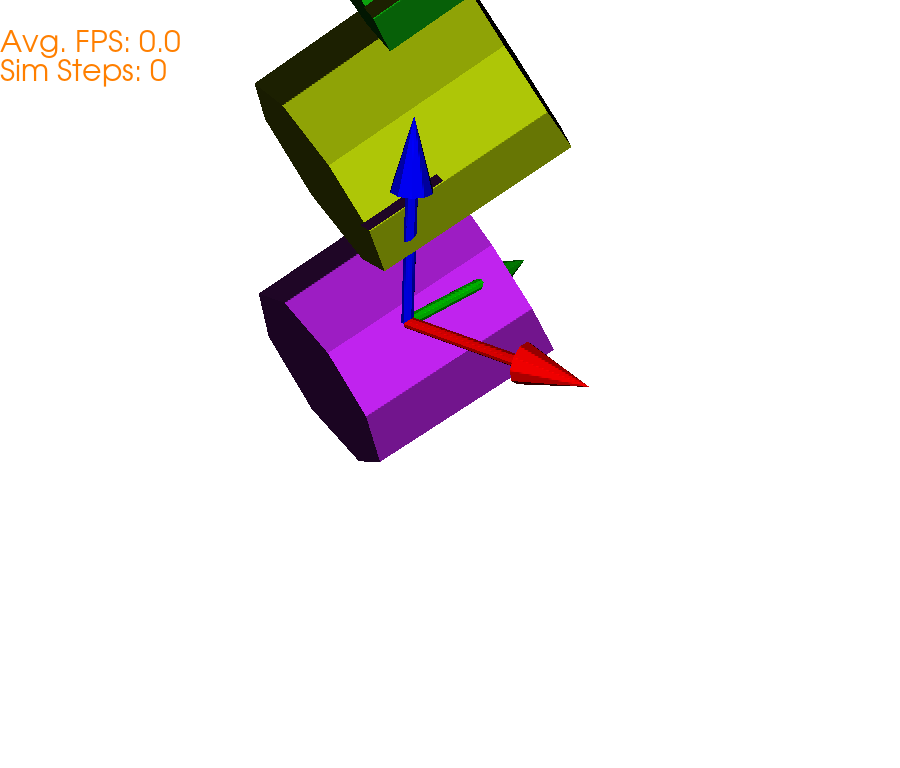Note
Go to the end to download the full example code
Chain Simulation#
This example simulation shows how to use pybullet to render physics simulations in fury. In this example we specifically render a Chain oscillating to and from.
First some imports.
import itertools
import numpy as np
import pybullet as p
from fury import actor, ui, utils, window
Setup pybullet and add gravity.
p.connect(p.DIRECT)
# Apply gravity to the scene.
p.setGravity(0, 0, -10)
Now we render the Chain using the following parameters and definitions.
# Parameters
n_links = 20
dx_link = 0.1 # Size of segments
link_mass = 0.5
base_mass = 0.1
radii = 0.5
joint_friction = 0.0005 # rotational joint friction [N/(rad/s)]
link_shape = p.createCollisionShape(
p.GEOM_CYLINDER,
radius=radii,
height=dx_link,
collisionFramePosition=[0, 0, -dx_link / 2],
)
base_shape = p.createCollisionShape(p.GEOM_BOX, halfExtents=[0.01, 0.01, 0.01])
visualShapeId = -1
link_Masses = np.zeros(n_links)
link_Masses[:] = link_mass
linkCollisionShapeIndices = np.zeros(n_links)
linkCollisionShapeIndices[:] = np.array(link_shape)
linkVisualShapeIndices = -1 * np.ones(n_links)
linkPositions = np.zeros((n_links, 3))
linkPositions[:] = np.array([0, 0, -dx_link])
linkOrientations = np.zeros((n_links, 4))
linkOrientations[:] = np.array([0, 0, 0, 1])
linkInertialFramePositions = np.zeros((n_links, 3))
linkInertialFrameOrns = np.zeros((n_links, 4))
linkInertialFrameOrns[:] = np.array([0, 0, 0, 1])
indices = np.arange(n_links)
jointTypes = np.zeros(n_links)
jointTypes[:] = np.array(p.JOINT_SPHERICAL)
axis = np.zeros((n_links, 3))
axis[:] = np.array([1, 0, 0])
linkDirections = np.zeros((n_links, 3))
linkDirections[:] = np.array([1, 1, 1])
link_radii = np.zeros(n_links)
link_radii[:] = radii
link_heights = np.zeros(n_links)
link_heights[:] = dx_link
rope_actor = actor.cylinder(
centers=linkPositions,
directions=linkDirections,
colors=np.random.rand(n_links, 3),
radius=radii,
heights=link_heights,
capped=True,
)
basePosition = [0, 0, 2]
baseOrientation = [0, 0, 0, 1]
rope = p.createMultiBody(
base_mass,
base_shape,
visualShapeId,
basePosition,
baseOrientation,
linkMasses=link_Masses,
linkCollisionShapeIndices=linkCollisionShapeIndices.astype(int),
linkVisualShapeIndices=linkVisualShapeIndices.astype(int),
linkPositions=linkPositions,
linkOrientations=linkOrientations,
linkInertialFramePositions=linkInertialFramePositions,
linkInertialFrameOrientations=linkInertialFrameOrns,
linkParentIndices=indices.astype(int),
linkJointTypes=jointTypes.astype(int),
linkJointAxis=axis.astype(int),
)
We remove stiffness among the joints by adding friction to them.
friction_vec = [joint_friction] * 3 # same all axis
control_mode = p.POSITION_CONTROL # set pos control mode
for j in range(p.getNumJoints(rope)):
p.setJointMotorControlMultiDof(
rope,
j,
control_mode,
targetPosition=[0, 0, 0, 1],
targetVelocity=[0, 0, 0],
positionGain=0,
velocityGain=1,
force=friction_vec,
)
Next, we define a constraint base that will help us in the oscillation of the chain.
root_robe_c = p.createConstraint(
rope, -1, -1, -1, p.JOINT_FIXED, [0, 0, 0], [0, 0, 0], [0, 0, 2]
)
# some traj to inject motion
amplitude_x = 0.3
amplitude_y = 0.0
freq = 0.6
base_actor = actor.box(
centers=np.array([[0, 0, 0]]),
directions=np.array([[0, 0, 0]]),
scales=(0.02, 0.02, 0.02),
colors=np.array([[1, 0, 0]]),
)
We add the necessary actors to the scene.
scene = window.Scene()
scene.background((1, 1, 1))
scene.set_camera((2.2, -3.0, 3.0), (-0.3, 0.6, 0.7), (-0.2, 0.2, 1.0))
scene.add(actor.axes(scale=(0.1, 0.1, 0.1)))
scene.add(rope_actor)
scene.add(base_actor)
# Create show manager.
showm = window.ShowManager(
scene, size=(900, 768), reset_camera=False, order_transparent=True
)
# Counter iterator for tracking simulation steps.
counter = itertools.count()
/opt/homebrew/Caskroom/miniforge/base/envs/py311-fury/lib/python3.11/site-packages/sphinx_gallery/gen_rst.py:722: UserWarning: We'll no longer accept the way you call the set_camera function in future versions of FURY.
Here's how to call the Function set_camera: set_camera(self_value, position='value', focal_point='value', view_up='value')
exec(self.code, self.fake_main.__dict__)
/opt/homebrew/Caskroom/miniforge/base/envs/py311-fury/lib/python3.11/site-packages/sphinx_gallery/gen_rst.py:722: UserWarning: We'll no longer accept the way you call the __init__ function in future versions of FURY.
Here's how to call the Function __init__: __init__(self_value, scene='value', title='value', size='value', png_magnify='value', reset_camera='value', order_transparent='value', interactor_style='value', stereo='value', multi_samples='value', max_peels='value', occlusion_ratio='value')
exec(self.code, self.fake_main.__dict__)
We define a couple of syncing methods for the base and chain.
# Function for syncing actors with multi-bodies.
def sync_actor(actor, multibody):
pos, orn = p.getBasePositionAndOrientation(multibody)
actor.SetPosition(*pos)
orn_deg = np.degrees(p.getEulerFromQuaternion(orn))
actor.SetOrientation(*orn_deg)
vertices = utils.vertices_from_actor(rope_actor)
num_vertices = vertices.shape[0]
num_objects = linkPositions.shape[0]
sec = int(num_vertices / num_objects)
def sync_joints(actor_list, multibody):
for joint in range(p.getNumJoints(multibody)):
# `p.getLinkState` offers various information about the joints
# as a list and the values in 4th and 5th index refer to the joint's
# position and orientation respectively.
pos, orn = p.getLinkState(multibody, joint)[4:6]
rot_mat = np.reshape(
p.getMatrixFromQuaternion(
p.getDifferenceQuaternion(orn, linkOrientations[joint])
),
(3, 3),
)
vertices[joint * sec : joint * sec + sec] = (
vertices[joint * sec : joint * sec + sec] - linkPositions[joint]
) @ rot_mat + pos
linkPositions[joint] = pos
linkOrientations[joint] = orn
We define a TextBlock to display the Avg. FPS and Simulation steps.
Timer callback to sync objects, simulate steps and oscillate the base.
def timer_callback(_obj, _event):
cnt = next(counter)
global t, fpss
showm.render()
t += 1.0 / freq_sim
if cnt % 1 == 0:
fps = showm.frame_rate
fpss = np.append(fpss, fps)
tb.message = (
"Avg. FPS: " + str(np.round(np.mean(fpss), 0)) + "\nSim Steps: " + str(cnt)
)
# some trajectory
ux = amplitude_x * np.sin(2 * np.pi * freq * t)
uy = amplitude_y * np.cos(2 * np.pi * freq * t)
# move base around
pivot = [3 * ux, uy, 2]
orn = p.getQuaternionFromEuler([0, 0, 0])
p.changeConstraint(root_robe_c, pivot, jointChildFrameOrientation=orn, maxForce=500)
# Sync base and chain.
sync_actor(base_actor, rope)
sync_joints(rope_actor, rope)
utils.update_actor(rope_actor)
# Simulate a step.
p.stepSimulation()
# Exit after 2000 steps of simulation.
if cnt == 130:
showm.exit()
# Add the timer callback to showmanager.
# Increasing the duration value will slow down the simulation.
showm.add_timer_callback(True, 1, timer_callback)
interactive = False
# start simulation
if interactive:
showm.start()
window.record(scene, size=(900, 768), out_path="viz_chain.png")

/opt/homebrew/Caskroom/miniforge/base/envs/py311-fury/lib/python3.11/site-packages/sphinx_gallery/gen_rst.py:722: UserWarning: We'll no longer accept the way you call the record function in future versions of FURY.
Here's how to call the Function record: record(scene='value', cam_pos='value', cam_focal='value', cam_view='value', out_path='value', path_numbering='value', n_frames='value', az_ang='value', magnification='value', size='value', reset_camera='value', screen_clip='value', stereo='value', verbose='value')
exec(self.code, self.fake_main.__dict__)
Total running time of the script: (0 minutes 0.112 seconds)
